

Getting Started Teaching Personal Finance in High School. Teaching students about the value of money is an important part of their learning, and many educators are starting to offer instruction in financial literacy, from embedding finance standards in math or social studies and economics to adding stand-alone personal finance courses to graduation requirements.
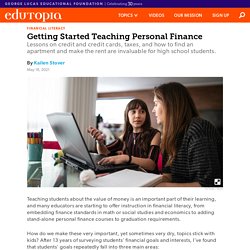
How do we make these very important, yet sometimes very dry, topics stick with kids? After 13 years of surveying students’ financial goals and interests, I’ve found that students’ goals repeatedly fall into three main areas: Living on their own Credit and credit cards Taxes Here is a beginner’s guide to building hands-on and real-world opportunities into personal finance education. How to Use Outlines to Support Student Note-Taking in Middle and High School. Note-taking is a skill that’s critical to most reading assignments, and sound, thorough notes can help students read for deeper comprehension.
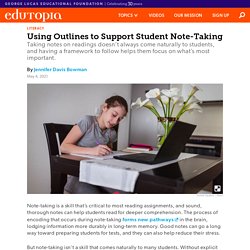
The process of encoding that occurs during note-taking forms new pathways in the brain, lodging information more durably in long-term memory. Good notes can go a long way toward preparing students for tests, and they can also help reduce their stress. But note-taking isn’t a skill that comes naturally to many students. Without explicit instruction, they can struggle to determine what’s relevant or most important—then wind up either trying to write down everything or taking notes that are too scant to be helpful. Many teachers give students a head start with note-taking for reading assignments by preparing an outline for them that provides structure and guidance, often by including prompts for key points (headings), relevant details (subheadings), and vocabulary.
The Benefits of Using Screencasts to Give Middle and High School Students Feedback. This year, I’ve been teaching all of my math classes both virtually and face-to-face.

The boarding school where I teach has brought some students back to campus, but most of our international students were not able to return. This means that I teach each class in person and then again, online, to my international students. To give both groups the same engaging experiences and learning opportunities, I’ve had to learn some new tricks. One tool that has helped immensely is using screencasting for feedback on projects and work. Powerful, Lesser-Known Tech Tools for Teachers. You’ve probably been teaching online or with blended approaches for months now.
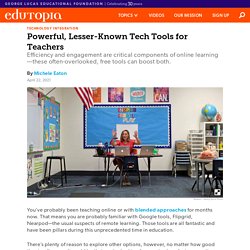
That means you are probably familiar with Google tools, Flipgrid, Nearpod—the usual suspects of remote learning. Those tools are all fantastic and have been pillars during this unprecedented time in education. How to Create a Better Breakout Room Experience for Middle and High School Students. The pandemic has completely transformed the way we teach and the way students interact.
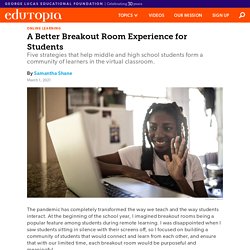
At the beginning of the school year, I imagined breakout rooms being a popular feature among students during remote learning. I was disappointed when I saw students sitting in silence with their screens off, so I focused on building a community of students that would connect and learn from each other, and ensure that with our limited time, each breakout room would be purposeful and meaningful. I’ve found that the success of breakout rooms hinges on a strong action plan. A Simple Way to Encourage Students to Read More Broadly.
Librarians and classroom teachers use various systems of classification to organize collections, from the Dewey Decimal System to interest or reading levels.
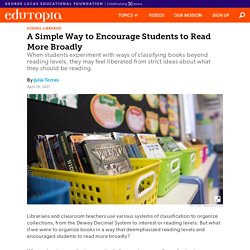
But what if we were to organize books in a way that deemphasized reading levels and encouraged students to read more broadly? When educators use the term vertical alignment, we are often referring to a progression of skills or content that increases in complexity. With respect to reading, rather than using achievement or assessment benchmarking levels, which is often discouraged in the librarian world, school librarians use designations that most closely align to education groupings and the comfort or reading-experience level of the reader. Labels like PB (picture book), CB (chapter book), MG (middle grade), YA (young adult), or AD (adult) are often placed on spine labels and in library catalogs to make it easier to identify titles that readers will enjoy, but the readers themselves rarely notice them. Mr. How to Select Instructional Strategies That Students Can Master.
When teachers prepare lessons, they often incorporate new strategies—graphic organizers, mnemonics, charts, word banks, written outlines, and other materials—in the hope that variety will attract and hold student interest.

Novelty can, however, have a negative impact on learning as students may spend more time trying to figure out how to use the strategy than on the concepts and big ideas they should be learning. And with so many different options to learn, students may not practice the strategy enough to use it independently of the teacher. To help select which strategies to use as the mainstays of instruction, teachers should consider the following questions: How can students use the strategy across disciplines? How does the strategy engage students as active participants in their learning? How—and Why—to Introduce Visual Note-Taking to Your Students. Unlike conventional note-taking, which can “border on the edge of transcription,” allowing students to try more visual, interpretive methods of processing materials helps them “identify connections between topics and themes,” writes Nimah Gobir for KQED.
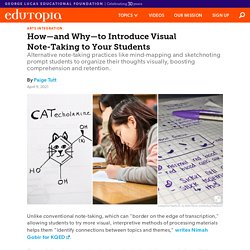
One technique known as sketchnoting—simple, hand-drawn renderings of things like facts, dates, or abstract concepts—allows students to respond to complex new ideas by engaging multiple parts of the brain simultaneously to deepen learning and retention, says Gobir. Instead of passively writing down everything a speaker is saying, the practice pushes students to actively process and make sense of what they’re learning.
“Sketchnoting doesn’t just lead to gains in keeping students’ attention, it’s a useful way for learners to organize and retain information,” she writes. Making a Shared Space for In-Person and Remote Learners. When her school went fully remote, Cathleen Beachboard—an eighth-grade English teacher in Fauquier County, Virginia—noticed some of her students struggling with connectivity issues.

Google Meet and Zoom used up a lot of bandwidth. The call-in feature presented an optimal alternative, though she still needed her students to see what she was doing in class. How to Select Instructional Strategies That Students Can Master. Even Older Kids Should Have Time to Read in Class. When Marilyn Pryle, a teacher in Clarks Summit, Pennsylvania, began scheduling silent reading time for her ninth- and 10th-grade students during the first 10 minutes of each class, it became “one of the most profound and rewarding shifts in classroom teaching I have made in my career,” she writes for MiddleWeb.
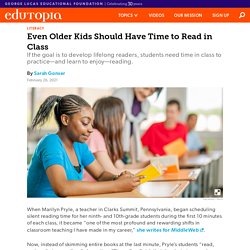
Now, instead of skimming entire books at the last minute, Pryle’s students “read, and can’t stop reading,” she writes. “They often finish their books in two weeks, or less. 7 Tips for Breakout Room Success in Middle and High School. Whether you use Zoom, Google Meet, or Microsoft Teams, having students in shared small groups can foster a deeper level of connection and communication, but depending on your class, the age of the students, and the content, it can be a scary moment to release control and trust the space. After all, one teacher cannot be everywhere, and if we are, are we really able to focus and offer support?
Breakout rooms allow me to connect with students and for them to connect with one another in a way that I believe is only possible in a smaller setting. 7 Tips for Creating and Maintaining Successful Breakout Spaces 1. Short and sweet. The Camera-On/Camera-Off Dilemma. While the professors wanted to respect student privacy, the lack of ambient feedback when the Zoom camera was off put a real damper on learning. “Instructors benefit from receiving nonverbal cues from their students such as smiles, frowns, head nods, looks of confusion, and looks of boredom, so that they can evaluate their teaching in real time and adjust accordingly to improve student learning,” Castelli and Sarvary write—emphasizing the value that comes from being able to read students’ faces. Students, too, benefit from being able to see each other onscreen. In the study, a majority indicated that “using videoconferencing helped build trust and rapport with other students and helped them to develop a sense of identification with others in their group.”
To refine their strategies around camera use, Castelli and Sarvary surveyed hundreds of students to identify their main privacy concerns. The students, it turns out, weren’t staying off-camera for the anticipated reasons. The Benefits of Guiding Middle School Students to Develop Good Habits. I recently had a student-parent conference conversation that didn’t go as planned. Me to fifth grader: What are your goals for this semester? Fifth grader: To be more responsible.
Simultaneous Learning: Blending Physical and Remote Learning. NOTE: This blog was originally published on Corwin Connect on September 21st, 2020. Early in the pandemic, distance learning was just that: instruction from a distance designed for remote delivery. We all brushed up on our understanding of synchronous and asynchronous learning.
As teachers innovated, we learned about what works best in asynchronous situations, including interactive videos of teachers modeling and thinking aloud as well as getting students to read and practice what they have been taught. Essentially, asynchronous was used for review and preview and helped the learning take hold. The Connection Between Working Memory and Elementary Students’ Tech Skills. When I taught a fourth-grade class how to build a website using Google Sites, I began counting the directions I gave my students. There were many—I had a large amount of information in an extremely compact lesson. Even though I used colors, visuals, and examples to make the lesson more interesting, I noticed that some students shut down, overwhelmed by the amount of information.